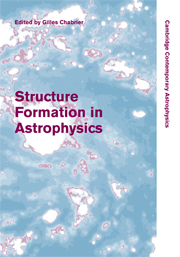Book contents
- Frontmatter
- Contents
- List of contributors
- Preface
- Part I Physical Processes and Numerical Methods Common to Structure Formations in Astrophysics
- 1 The physics of turbulence
- 2 The numerical simulation of turbulence
- 3 Numerical methods for radiation magnetohydrodynamics in astrophysics
- 4 The role of jets in the formation of planets, stars and galaxies
- 5 Advanced numerical methods in astrophysical fluid dynamics
- Part II Structure and Star Formation in the Primordial Universe
- Part III Contemporary Star and Brown Dwarf Formation
- Part IV Protoplanetary Disks and Planet Formation
- Part V Summary
5 - Advanced numerical methods in astrophysical fluid dynamics
Published online by Cambridge University Press: 11 August 2009
- Frontmatter
- Contents
- List of contributors
- Preface
- Part I Physical Processes and Numerical Methods Common to Structure Formations in Astrophysics
- 1 The physics of turbulence
- 2 The numerical simulation of turbulence
- 3 Numerical methods for radiation magnetohydrodynamics in astrophysics
- 4 The role of jets in the formation of planets, stars and galaxies
- 5 Advanced numerical methods in astrophysical fluid dynamics
- Part II Structure and Star Formation in the Primordial Universe
- Part III Contemporary Star and Brown Dwarf Formation
- Part IV Protoplanetary Disks and Planet Formation
- Part V Summary
Summary
Abstract
Computational gas dynamics has become a prominent research field in both astrophysics and cosmology. In the first part of this chapter, we intend to briefly describe several of the numerical methods used in this field, discuss their range of application and present strategies for converting conditionally stable numerical methods into unconditionally stable solution procedures. The underlying aim of the conversion is to enhance the robustness and unification of numerical methods and subsequently enlarge their range of applications considerably. In the second part, Heitsch presents and discusses the implementation of a time-explicit magneto hydrodynamic (MHD) Boltzmann solver.
PART I
Numerical methods in AFD
Astrophysical fluid dynamics (AFD) deals with the properties of gaseous matter under a wide variety of circumstances. Most astrophysical fluid flows evolve over a large variety of different time and length scales, henceforth making their analytical treatment unfeasible.
On the contrary, numerical treatments by means of computer codes have witnessed an exponential growth during the last two decades due to the rapid development of hardware technology. Nowadays, the vast majority of numerical codes are capable of treating large and sophisticated multi-scale fluid problems with high resolutions and even in 3D.
The numerical methods employed in AFD can be classified into two categories (see Figure 5.1):
Microscopic-oriented methods: These are mostly based on N-body (NB), Monte Carlo (MC) and on the Smoothed Particle Hydrodynamics (SPH).
Grid-oriented methods: To this category belong the finite difference (FDM), finite volume (FVM) and finite element methods (FEM).
- Type
- Chapter
- Information
- Structure Formation in Astrophysics , pp. 110 - 130Publisher: Cambridge University PressPrint publication year: 2009
- 1
- Cited by



